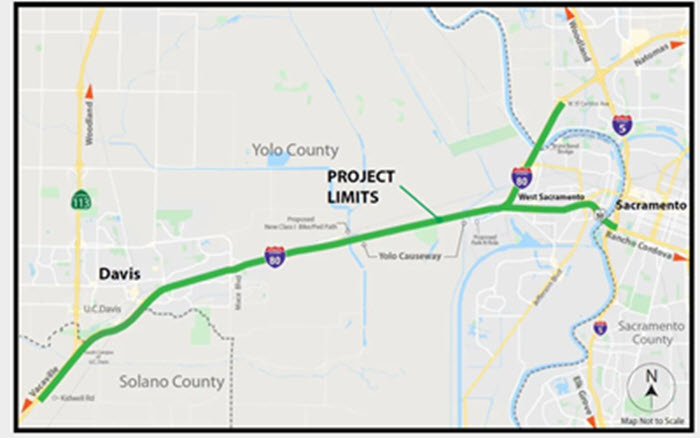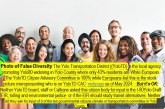

Masum Patwary
Environmental Scientist
Caltrans District 3
Dear Mr. Patwary:
Thank you for the opportunity to review the Draft Environmental Impact Report (“DEIR”) for the Yolo 80 Corridor Improvements Project (“Project”). The City of Davis (“Davis”) respectfully submits these comments to help Caltrans to ensure that the Environmental Impact Report complies with the California Environmental Quality Act (“CEQA”). Public Resources Code sections 21000-21889, CEQA Guidelines sections 15000-15387.
The City’s concerns fall into the following general categories:
Project Description
An inaccurate or incomplete project description may render the analysis of significant environmental impacts inherently unreliable. While extensive detail is not necessary, the law mandates that EIRs should describe proposed projects with sufficient detail and accuracy to permit informed decision-making. (CEQA Guidelines section 15124).
- Chapter 3.1.1 does not discuss the phasing of the project. Our understanding of the project is that there is insufficient funding to complete the entire project in one phase so construction will have to be phased. If this is correct, a discussion of project phasing should be included in the project description and is necessary to fully inform the public about the construction timing and project schedule.
- Chapter 1.5 of the DEIR addresses alternatives considered but rejected. The City requests Caltrans include and analyze a project alternative that converts an existing general-purpose lane to a tolling lane or HOT lane. Caltrans should explain why the alternative of converting an existing lane to HOV was considered but the option of a toll lane, which could generate revenue for transit improvements, was not
Climate Change, Local Plan Consistency
The DEIR determines that the impacts on climate change, including air quality and greenhouse gas emissions (“GHG”) will be less than significant after implementation of standard mitigation measures as described in Exhibit E to the DEIR.
- Chapter 3.4.3.3 describes the applicable Regional Plans that address Greenhouse Gas Emissions (“GHG”) reduction policies or strategies. The City of Davis adopted its Climate Action and Adaptation Plan on April 18, 2023 and requests that it be included in the analysis of consistency with local plans. The City understands that Caltrans is not required to include the Davis CAAP in the DEIR analysis as it was adopted after Caltrans released the Notice of Preparation for the Project DEIR. The City recommends that Caltrans do so, however, given that the CAAP represents the City’s most recent policy document related to Specifically, the CAAP includes three climate action goals relevant to the project – (1) expand public transit (TR6), (2) develop Transportation Demand Management (TR9), and (3) strengthen regional transit (TR7). A copy of the CAAP is attached for your convenience.
Traffic and Transportation
VMT Mitigation Measures
Vehicles Miles Traveled measures the amount of travel for all vehicles in a geographic region over a given period of time, typically a one-year period. It is calculated as the sum of the number of miles traveled by a vehicle. CEQA requires that an EIR identify “all feasible measures which could minimize significant adverse impacts.” CEQA Guidelines Section 15126.4(a)(1). The City submits the following comments related to Caltrans’ mitigation measures related to Transportation/VMT impacts.
- The DEIR concludes that the impacts of the project on vehicles miles traveled will be significant and unavoidable even after the implementation of mitigation. The DEIR identifies eight “VMT Reduction Measures.” The City notes that these reduction matters are not included in the table of mitigations in Exhibit C, however, and it is unclear if Caltrans intends to adopt them as formal mitigation measures under CEQA. Caltrans is obligated to identify all feasible VMT mitigation measures, even if they will not result in mitigation of VMT impacts to a “less than significant” level. CEQA Guidelines Section 15126.4(a)(1).
- The DEIR states that Caltrans is making a commitment to contribute $55 million toward the measures. However, full implementation of these VMT-reducing will require substantial additional financial The specific process by which this additional funding will be obtained is not specified in detail, and the DEIR appears to assume the additional funding will come from tolls. CEQA requires that mitigation measures be “fully enforceable through permit conditions, agreements, or other legally binding instruments.” CEQA Guidelines Section 15126.4(a)(2). The DEIR’s “Mitigation Reduction Measures” fail to meet this requirement, as long-term funding for the mitigation measures is not currently available, and the DEIR fails to propose a legally binding pathway to funding them. The City notes that Caltrans could improve the enforceability of the VMT mitigation measures by seeking to enter binding agreements with the affected agencies who will establish a tolling authority, and developing an agreed upon methodology for establishing toll amounts that would fully fund the ongoing mitigation measures. Finally, it would be important for the tolling agencies to agree to divert revenue towards the mitigation measures. If this is not feasible, then Caltrans could commit to funding the mitigation measures until tolls are established and the mitigation measures could be funded through binding and legally enforceable agreements.
- Similarly, the City notes that full implementation of the VMT mitigation measures is largely outside the legal jurisdiction of Caltrans as ongoing funding will depend on the intervening actions of multiple other public While the City understands that Caltrans cannot control the discretionary actions of other public agencies, as noted above, Caltrans could either seek agreement from the affected agencies, or agree to fund the mitigation measures itself until such time as tolling agencies are able to fully fund them. The DEIR does not look at this option or analyze its feasibility.
- In addition to lacking legal enforceability, the proposed VMT Reduction Measures appear to defer mitigation of ongoing VMT impacts to a later date without meeting the requirements of CEQA Guidelines Section 15126.4(a)(1)(B), including the identification of specific performance standards that the mitigation measure should achieve and identifying potential actions that could attain that result.
- Finally, even if the VMT Reduction Measures are fully implemented and funded over the long term, they would not be sufficient to offset the VMT impacts of Build Alternatives 2-5. In addition to revising the 8 VMT Reduction measures to meet CEQA requirements for enforceability and specificity, the City requests that Caltrans review options to further reduce the VMT impacts of the Project. The DEIR does not include any analysis of other potential mitigation measures besides the eight proposed measures, and does not provide a basis for concluding that these are the only feasible mitigation measures to address VMT for the Project.
- Table 2.1-28 states that the cost to increase Route 42A and 42B services for 15- minute headways during morning and afternoon peak hours would be $16 million annually. The City asks that Caltrans reexamine this cost estimate. The City notes that the expansion of the Causeway Connection was estimated to cost less than $1 million per year. It is not clear to the City that expanding the routes of two 42 bus routes would cost 16 times more than the Causeway Connection. If those numbers are correct, the City asks that Caltrans look at expanding other bus routes (e.g. 43, 43R, 230) instead of discarding the measure completely.
- Section 2.1.10.8 includes subsidizing transit passes and/or eliminating fares as a potential VMT reduction measure. Caltrans’s methodology for estimating the VMT reduction due to a voluntary trip reduction plan should be more fully described and analyzed. Since the analysis time frame uses 2019 traffic data through both the NCST calculator and SACSIM more analysis should be done to make sure that any mitigation measures that restore transit service to 2019 levels are not double counting or over estimating the VMT benefits that they would provide.
- With respect to Tables 2.1.27 and 2.1.28 related to VMT Reducing Measures, the City requests Caltrans to consider that commuters travel I-80 from Dixon to Davis and Although there is Solano Express bus service between Dixon and Davis, expansion of this service on the blue line to Sacramento with improved frequencies, especially between Dixon and Davis would likely have a beneficial impact on VMT. Another option to consider would be a Capitol Corridor train stop in Dixon. The Yolobus 42 routes cover long distances. Shorter, more frequent routes (particularly during commute times) between Woodland and Davis should also be considered. While the City acknowledges that this latter option would not substantially change the VMT on I-80, it could mitigate some of the I-80 GHG impacts.
- Table 1.28 rejected a mitigation calling for increases to parking costs at UC Davis and Downtown Sacramento since currently there are no plans to proceed with this program. The VMT reduction estimate from this measure is significant and the City request that Caltrans consider working with the affected agencies to increase parking costs by a lesser amount in order to provide some VMT mitigation.
Induced Demand Analysis
- The City notes that the DEIR contains contradictory information about whether commercial or truck traffic is considered in the analysis of induced demand and elasticity. The Fehr and Peers memorandum of November 16, 2023 states that increases to commercial traffic would be 19-29% based on induced demand, but later states that “With commercial driving excluded, the automobile daily induced VMT has an elasticity of 0.71.” Additional explanation of why commercial traffic should be excluded from this analysis would be helpful in terms of understanding the agency’s induced demand methodology.
Safety Concerns
- Section 2.1.10.3 “Collision Data” summarizes the number of collisions and collision rates for the freeway segments of the Project Area. The Project proposes reducing the inner shoulder width in order to create the managed lane through the City of Davis and onto the Causeway. The reduction or elimination of the inner shoulder should be analyzed to determine if this will increase the likelihood of collisions and to evaluate impacts on local first responders, such as police, fire and emergency services.
- Along the same lines, the DEIR should analyze to the increased risk of collisions during the construction period. The City understands that staged traffic control, such as narrower lanes, no (or minimal) shoulders, and lane shifts have had an impact on collision rates during the current work on I-80 across the Causeway and in West Sacramento. The increased number of collisions has also had an impact on the City of Davis due to the increase in emergency calls for service to assist with incidents on the Causeway. For example, the Davis Fire Department saw an increase in calls to the Causeway between October 12th and November 22nd . The City received calls for service for 9 incidents in that same time frame in 2022, but this figure nearly doubled to 17 incidents in 2023.
Air Quality
- Section 3.4.4.1 “Operation Emissions” as well as Table 3.4.2, analyzes CO2 emissions from fossil fuel combustion and its impact on GHG emissions. But the model used for this calculation does not account for “induced ” A project that reduces travel time can lead to changes in traveler behavior that can increase the overall amount of travel, and therefore the Project may result in “induced travel.” The DEIR needs to either explain how induced travel impacts were evaluated for GHG and air quality impacts or provide a full analysis these impacts.
- Section 3.4.5 CEQA Conclusion determines that the Build Alternative will result in additional vehicle capacity that will result in an increase of impacts from The Project’s very modest decrease in projected GHG emissions in 2049 are attributed to newer more fuel-efficient fleets and the increase in electric vehicles. The City requests a more detailed analysis of the Project’s consistency with the State of California’s goals of a 40% reduction (below 1990 levels) by 2030 and 85% reduction by 2050 (2022 Scoping Plan, ARB).
- Section 3.4.6.1 (p. 3-64) describes a Governor’s Office of Planning and Research report (2015) that identified a 50% reduction in petroleum use in cars and trucks by 2030 as a “key state goal” for reducing greenhouse gas Here again, the Project should be fully evaluated for consistency with State goals, even where they are not legally binding.
Miscellaneous/Non-CEQA Comments
- The City notes that the public circulation period for the DEIR has been marked by noticing flaws, with incorrect documents loaded to the website at various points, supporting information on the VMT analysis posted later than the rest of the DEIR,
and repeated reports that physical copies of the documents were not available for significant periods of time at the Mary L. Stephens Davis Library. For all of these reasons, as well as the additional time it affords for review, the City appreciates the extension of the public comment period to January 12, 2024. However, one may argue that the extension provided may not be sufficient to account for these noticing deficiencies and we continue to have concerns about the adequacy of the availability of documents as noted above, particularly as it pertains to the document access to interested members of the community who may wish to participate in the DEIR review and comment process.
- Section 1.10.7 Environmental Consequences proposes adding Class II bike lanes to County Road 32A, at the intersection of 32A/105 and the Class I bikeway that parallels I-80. When this is designed, the City requests that a safe crossing to access to the Class I bikeway be developed for westbound cyclists to use.
- We note that Project T-8 in Table 3-3 incorrectly refers to “Olive Hill Lane” and “Olive Hill Road” instead of “Olive Drive.”
In addition, the city received comments from two City commissions: the Bicycling, Transportation, and Street safety Commission (BTSSC) and the Natural Resources Commission (NRC). Their comments have been attached for your consideration as well.
Thank you again for the opportunity to comment on this DEIR. Please feel free to contact Ryan Chapman, Assistant Director of Public Works Engineering and Transportation if you have any questions. He can be reached at rchapman@cityofdavis.org.
Sincerely,
Mike Webb
City Manager





